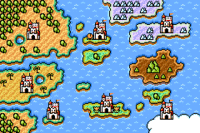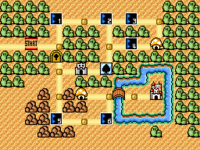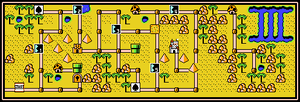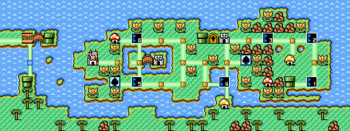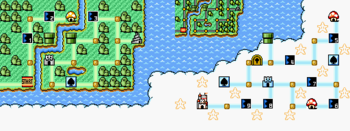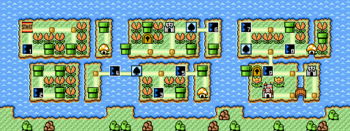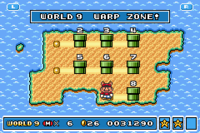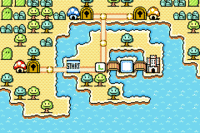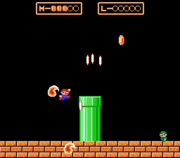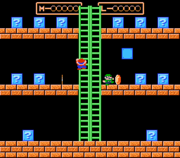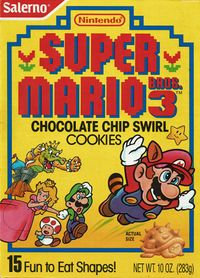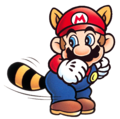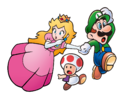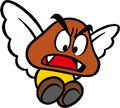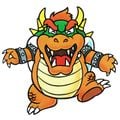Super Mario Bros. 3
- This article is about the game for the Nintendo Entertainment System. For other uses, see Super Mario Bros. 3 (disambiguation).
Template:Infobox Super Mario Bros. 3 is a platform action-adventure game for the Famicom and NES and is officially the third installment in the Super Mario series. It was released for consoles in Japan on October 23, 1988, in North America on February 12, 1990, and in Europe and Australia on August 29, 1991. Prior to its North American release on the NES, Super Mario Bros. 3 was ported to the Nintendo PlayChoice-10.[1] It was later released in the US on the Wii's Virtual Console in 2007, the 3DS's Virtual Console in early 2013, and the Wii U's Virtual Console in late 2013. It was also remade for the 1993 SNES compilation game Super Mario All-Stars, and for the Game Boy Advance in 2003 as Super Mario Advance 4: Super Mario Bros. 3, the final installment of the Super Mario Advance series. It was also released as a reward that Club Nintendo users could purchase with their coins for the Wii Virtual Console on June 3, 2013.
Super Mario Bros. 3 has been considered one of the greatest games of all time, with its huge success attributed to its complexity and challenging levels. The game introduces six new power-ups: the Super Leaf, the Tanooki Suit, the Magic Wing, the Frog Suit, the Hammer Suit, and Goomba's Shoe. It also features new moves, items and enemies. It also features special non-level parts of each world: Toad Houses, where items can be obtained, and Spade Panels, where lives can be obtained, as well as rarer areas such as the White Mushroom House and the Treasure Ship. Up to 28 items can be held in the item inventory, 7 per row. When the 29th item is obtained, it will overwrite the 28th item, removing it from the inventory.
Shortly after the release of the game, a cartoon named The Adventures of Super Mario Bros. 3 was made. The cartoon was based on the game, but with a different plot. In the cartoons, King Koopa and the Koopalings tried to take over the real world as well as the Mushroom Kingdom. The cartoon series was produced by DIC Entertainment Productions in association with Nintendo.
Story
The following text is taken directly from the instruction booklet.
The Mushroom Kingdom has been a peaceful place thanks to the brave deeds of Mario and Luigi. The Mushroom Kingdom forms an entrance to the Mushroom World where all is not well.
Bowser sent his seven children to make mischief as they please in the normally peaceful Mushroom World. They stole royal magic wands from each country in the Mushroom World and used them to turn their kings into animals. Mario and Luigi must recover the royal magic wands from Bowser's seven kids to return the kings to their true forms.
"Goodbye and good luck!" said the Princess and Toad as Mario and Luigi set off on their journey deep into the Mushroom World.
Peace has returned to the Mushroom Kingdom thanks to the efforts of Mario and Luigi; however, Bowser sent his own seven children (Larry, Morton, Wendy, Iggy, Roy, Lemmy, and Ludwig) to the other countries of the Mushroom World. The Mushroom Kingdom forms a gateway to these lands, and the Koopalings have stolen the respective royal magic wands of the seven kings, using them to transform the kings into various helpless creatures. Mario and Luigi vow to go and stop the Koopalings' mischief, and change the kings back into their normal form. At the end of each world, Mario and Luigi fight one of the Koopalings, and after the match is over, retrieve the wand from the Koopaling to turn the king back to normal. While the brothers are out in their adventure, Bowser kidnaps Princess Toadstool and takes her to his lair in Dark Land. The brothers go to Dark Land and fight Bowser. After defeating Bowser, they save the princess and restore peace once again.
Gameplay
Super Mario Bros. 3 plays similarly to Super Mario Bros., with several additions. The game features a world map where the player can choose which path to take and which level to play. Toad Houses and Spade Panels are also found on the world map. Halfway through each world, Mario or Luigi enter a fortress, where they fight Boom Boom. At the end of each world, they enter the world's airship, where one of the seven Koopalings is fought. After defeating the Koopaling, Mario or Luigi restores the king back to his normal state.
The first player controls Mario, while the second player controls his brother, Luigi, with the two players taking turns. New moves include being able to pick up an object and kick it, and the Slope Slide, which allows Mario or Luigi to slide down a hill, a move which has been carried over in the future Mario games. The Fire Flower returns in this game, where it acts as it does in Super Mario Bros., allowing Mario or Luigi to transform into their Fire forms and shoot fireballs. Several new power-ups are also introduced, including the Super Leaf, a leaf power up that transforms Mario or Luigi into their Raccoon forms, allowing them to fly into the sky, and the Hammer Suit, which transforms the brothers into their Hammer forms, letting them throw hammers at enemies.
Controls
| In a level | On the world map | |
|---|---|---|
| NES |
|
|
| SNES |
|
|
| Game Boy Advance |
|
|
| Wii Remote |
|
|
| Wii Classic Controller |
|
|
| Nintendo 3DS |
|
|
| Joy-Con / Nintendo Switch Pro Controller |
|
|
Characters
Playable characters
Supporting characters
Enemies
| Image | Name | Description |
|---|---|---|
| Angry Sun | The Angry Sun is a small Sun with an angry face. It only appears in two levels: one in World 2- | |
| Baby Cheep | Baby Cheeps are usually found with Big Bertha. | |
| Big Bertha | Big Berthas are giant Cheep-Cheeps who carry babies in their mouths. Occasionally, they stop to open their mouths and let their babies briefly swim out before resuming their movement. | |
| Bloober | Bloobers are common underwater foes. They swim diagonally and follow Mario. | |
| Bloober baby | Four mini-Bloobers that follow their parents, and are sent in the player's direction by Scattering Bloobers. | |
| Bloober with kids | These Bloobers have four children following them. The Scattering Bloober type has an additional move: when she begins to glow, her kids will form a circle around her and radiate outward. More babies appear to replace the ones she lost a few seconds later. | |
| Bob-omb | Bob-ombs are living bombs. They typically appear walking on the ground. If Mario stomps on one, it will become stationary and capable of being picked up and used as a weapon. However, it will explode in a few seconds, even if Mario is still holding it. Keyless Bob-ombs are launched from cannons, and explode on their own after a few seconds. | |
| “Boo” Diddly | “Boo” Diddlies are small white ghosts. They are shy, stopping when Mario looks at them. Once Mario looks away, they will resume their chase. | |
| Boomerang Brother | Boomerang Brothers are like Hammer Brothers, except that their weapon of choice is the Boomerang. When they attack, the boomerangs they throw will double back for a second attack from the opposite direction. They appear as map enemies in World 2. | |
| Boss Bass | Boss Basses are giant Cheep-Cheeps that swim on the surface of the water. When Mario gets too close, they lunge out of the water to eat him. Boss Bass can defeat Mario in one gulp, even if he transforms into Statue Mario. In the levels that they appear in, the tide rises and falls, making Mario an easy target. | |
| Bowser Statue | Bowser Statues are sculptures of King Bowser himself found in his castle. They are more than just egotistical decoration; many of them are capable of firing lasers downward in a 45 degree angle. | |
| Bullet Bill | Bullet Bills are large black bullets launched by Turtle Cannons. | |
| Buster Beetle | Buster Beetles are Buzzy Beetles that can pick up Ice Blocks and throw them at Mario. However, they are beaten by any attack, even fireballs. | |
| Buzzy Beetle | Buzzy Beetles are turtles with fire-resistant shells. Otherwise, they act like green Koopa Troopas when on the ground. Buzzy Beetles can also walk on the ceilings of caves, and will fall from them while spinning in their shells when Mario approaches. | |
| Cannon | Cannons shoot cannonballs. | |
| Cannonball | Cannonballs are heavy metal spheres that are launched from cannons. | |
| Chain Chomp | Chain Chomps are dog-like ball and chain creatures. They generally lunge towards Mario. They are usually attached to a block, but if 160 seconds go by, they will break free. | |
| Cheep-Cheep | Cheep-Cheeps are fish foes that patrol shallow water. They come in red and green. The red variety jumps from the water in various ways and can swim quite fast while doing so, while the green kind slowly swims back and forth. | |
| Colossal Koopa Paratroopa | Colossal Koopa Paratroopas are winged Green Gargantua Koopa Troopas. They only follow the hopping behavior. One stomp will make them lose their wings, reverting them to Green Gargantua Koopa Troopas. | |
| Crab | Crabs require two hits in order to flip them upside-down. The first hit only makes the angry and speeds them up. Crabs only appear in Battle Mode. | |
| Dry Bones | Dry Bones is the animated skeleton of a Koopa Troopa, usually found in fortresses. If they are stomped, they collapse into a pile of bones. Moments later, however, the bones will rise back up off the ground and come back to life. | |
| Fiery Walking Piranha | This special Walking Piranha can spit multiple fireballs. Only one is found in the game, in World 7-8. | |
| Fighter Fly | Fighter Flies constantly hop their way across the screen, only briefly vulnerable. Fighter Flies only appear in Battle Mode. | |
| Fire Brother | Fire Brothers are the least common type of the Hammer Brother family. Only a few Fire Brothers appear in the entire game; two are found in a secret part of World 2, and another one appears in in the first Hand Trap level of World 8. They have red skin and they spit fireballs at Mario. | |
| Fire Chomp | Fire Chomps are floating creatures resembling Chain Chomps with four fireballs for a chain. They fly freely and spit fireballs at Mario. When they run out of fireballs, they chase Mario before they explode. | |
| Fireball | Fireballs only appear in Battle Mode. There are three types: the first travels horizontally in a wavy pattern, the second bounces around diagonally, and the last is shot out of a pipe in a bonus stage. The former two emerges from the sides when enough time has passed. All share the same red sprite. | |
| Firesnake | The Firesnake is a flame with four fireballs behind it. Firesnakes chase Mario in an effort to hurt him. They hop towards Mario. | |
| Giant Cannonball | Giant Cannonballs are big metal spheres that are launched from cannons at high speeds. | |
| Giant Koopa | Just like the Giant Land variety of Goomba, Koopa Troopas also come in tremendous sizes and come in Green Gargantua Koopa Troopa and Red Giant Koopa Troopa varieties. They have the same vulnerabilities of normal Koopa Troopas, but their larger size makes them a more dangerous opponent to deal with. They each act the same as their smaller counterparts. | |
| Goomba | Goombas wander in whatever direction they happen to be going, mindlessly falling off platforms as they go. | |
| Grand Goomba | Grand Goombas are twice-as-large Goombas found in Giant Land. Other than their large size, they are identical to regular Goombas, and can be removed with one stomp. | |
| Hammer Brother | Hammer Brothers are the Koopa Troops's elite forces that attack Mario by throwing hammers in an upward arc. While not very common in traditional stages, they wander around the maps of Worlds 1, 3, 5, and 6. They tend to appear in pairs, which can make it difficult to find an opening to attack. | |
| Hot Foot | Hot Foots are animated candle flames. Their behavior is similar to Boos. If Mario faces one, it will stand still. Once Mario looks away, it will resume walking towards him. | |
| Jelectro | Jelectros are glowing electric jellyfish that remain stationary in the water. They are invincible, their touch is lethal, and they tend to hang out in groups. | |
| Koopa Paratroopa | Koopa Paratroopas are winged Koopa Troopas. A stomp removes their wings and turns them into normal Koopa Troopas. However, if Mario hits the block under a Paratroopa, it will tuck into its shell. Other attacks will defeat it completely. Like their wingless cousins, there are two versions of Koopa Paratroopa: green and red shelled Koopas. The green kind tend fly back and forth or hop forwards, while the red ones fly up and down. | |
| Koopa Troopa | Koopa Troopas are found throughout the Mushroom World. One stomp will send it hiding in its shell. The shell can be used to defeat enemies, break empty bricks and hit blocks with items. Other attacks, however, will defeat it completely. Green shelled Koopa Troopas walk in one direction and fall over any edge they encounter. Red shelled Koopa Troopas will turn about if they come to a gap. | |
| Kuribo's Goomba | Kuribo's Goomba is a Goomba wearing a special shoe; they try to stomp Mario with it. If Mario can bump the Goomba from under a block, then he can use the displaced shoe. Any other attack, however, will destroy the shoe as well. | |
| Lakitu | Lakitus are cloud-riding Koopas. They hover back and forth in the air above Mario, tossing a never-ending supply Spiny's Eggs to the ground. | |
| Lava Lotus | Lava Lotuses are large flowers that live underwater. They are capable of generating up to five fireballs (which can go through platforms) and releasing them. | |
| Micro-Goomba | Micro-Goombas are small Goombas. They are dropped by brown Para-Goombas. They drag Mario down if touched. Mashing | |
| Missile Bill | Missile Bills are flashing red Bullet Bills that turn around once if it misses Mario. | |
| Muncher | Munchers are invincible, black Walking Piranha-like flowers. They tend to grow in large clusters. The only way to defeat a Muncher is turn it into a coin with a Switch Block and collect it. Invincible Mario can walk on Munchers. Some of them are frozen in Ice Blocks. | |
| Para-Beetle | Para-Beetles are winged Buzzy Beetles. However, Mario can hop on their back for a ride, unlike with other winged foes. They only appear in World 5-6. | |
| Para-Goomba | Para-Goombas are winged Goombas. They become regular Goombas after just one stomp. Brown Para-Goombas fly around, dropping Mugger Micro-Goombas onto Mario. Red Para-Goombas hop while chasing Mario. | |
| Pile Driver Micro-Goomba | Pile Driver Micro-Goombas are Micro-Goombas inside dull bricks. They like to hide near other brick, jumping when Mario gets close. | |
| Piranhacus Giganticus | Giant Piranha Plants only reside in Giant Land. They will rise in and out of pipes, regardless of whether Mario is standing next to them or not. Like regular Piranha Plants, they appear in two colors, although this makes no difference in their behavior. | |
| Piranha Plant | Piranha Plants are carnivorous plants that live in pipes or quicksand. However, Piranha Plants will not emerge from their pipe if Mario is touching or standing directly on top of it, unless the pipe is sideways. Red Piranha Plants have two segments of leaves, while green ones have only one, though the sideways ones are red with one segment. | |
| Podoboo | Podoboos are large fireballs that leap from lava. | |
| Ptooie | Ptooies are usually mobile Piranha Plants that blow spiked balls. Occasionally, Ptooies will blow the spiked ball high into the air, allowing Mario to jump past them. | |
| Rocket Engine | Rocket Engines are cylindrical blocks that expel flames found on airships. Tanooki Mario can actually defeat the flame jets by transforming into a statue above them. However, a new flame will appear after a few seconds. | |
| Rocky Wrench | Rocky Wrenches are mole-like turtles. Upon sighting Mario, a Rocky Wrench will pop out of its hole in an airship or vehicle, and chuck wrenches at him before descending back into its hole. | |
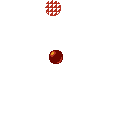
|
Rotodisc | Rotodiscs are shining discs that spin around an orb or block. They sometimes appear in pairs known as Duo-Roto-Discs. Mario can only destroy them as Statue Mario. |
| Sledge Brother | Sledge Brothers are larger Hammer Brothers. These tubby turtles have green skin and they throw hammers, albeit slower than Hammer Brothers. Sledge Brothers make big jumps, and if Mario is standing when a Sledge Brother lands, he will be stunned. They appear mostly in Giant Land, where they are mostly map enemies. | |
| Spike | Spikes are small green turtles which pull spiked balls out of their mouths before throwing them at Mario. | |
| Spiny | Spinies are small turtles with spikes all over their shells; they cannot be stomped. However, if Mario bumps a block under a Spiny, or attacks it with a raccoon tail, it will tuck into its shell. They can also drop from the ceiling. Spinies also appear in the Battle Mode. | |
| Spiny Cheep-Cheep | Spiny Cheep-Cheeps swim even faster than red Cheep-Cheeps and can appear from both sides of the screen. They only appear in World 7-4. | |
| Spiny Egg | Eggs tossed by Lakitu that bounce off of walls and hatch into Spinies upon hitting the ground. The Green variety rolls along the ground after Mario. | |
| Stretch | Stretches are Boos attached to platforms. They are found exclusively in fortresses and are more of an obstacle than a true enemy. As Mario attempts to pass, a Boo will rise from the top and/or bottom of the platform and move along the surface. Stretches are usually found in groups. | |
| Thwomp | Thwomps are living rectangular rocks. They try to squash Mario under their weight whenever he gets near or under them. | |
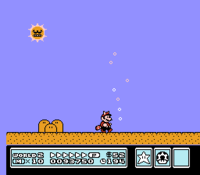
|
Tornado | This whirlwind only appears in World 2- |
| Turtle Cannon | Turtle Cannons shoot Bullet Bills. They are placed strategically throughout many levels, even on the ground, where Mario cannot duck beneath the bullets flying his way. | |
| Venus Fire Trap | Venus Fire Traps are Piranha Plants that spit one or two fireballs at Mario. Like normal Piranha Plants, they reside in pipes or quicksand, and they will not appear if Mario is near or on their pipe, and appear in two colored varieties depending on their height. | |
| Walking Piranha | Walking Piranhas are little, white Piranha Plants. They sit still or patrol an area and leap up at Mario when he tries to pass them. |
Bosses
| Image | Name | Description |
|---|---|---|
| Boom Boom (as miniboss) | A Koopa who guards every fort. He attacks by walking and flying or jumping. | |
| Larry Koopa | The boss of Grass Land. He only attacks by shooting magic blasts and jumping. | |
| File:SMB3MortonKoopaJr.Sprite.png | Morton Koopa Jr. | The boss of Desert Land. He attacks like Larry. |
| Wendy O. Koopa | The boss of Water Land. She attacks by shooting candy rings (up to three) that bounce while jumping high. | |
| Iggy Koopa | The boss of Giant Land. He attacks by shooting magic blasts while jumping high. | |
| Roy Koopa | The boss of Sky Land. He shoots magic blasts and can stun Mario by landing on the floor if Mario is grounded. This also goes for his shell attack. | |
| Lemmy Koopa | The boss of Ice Land. He simply moves back and forth on his magical ball, while attacking with smaller balls. | |
| Ludwig von Koopa | The boss of Pipe Land. He attacks like Roy. | |
| Bowser | The boss of Dark Land. He breathes fire and tries to Ground Pound on Mario, causing the floor to break. |
Transformations
| Image | Name | Description |
|---|---|---|
| Small Mario | Mario's weakest form; he starts each life in this form. If Mario touches an enemy in damaging areas or damaging obstacles while in this form, he loses one life. | |
| Super Mario | The form Mario turns into after obtaining a Super Mushroom in Small form. Mario gains the ability to break bricks in this state. If Mario touches an enemy while in this form, he shrinks back to his Small form. | |
| Fire Mario | After utilizing a Fire Flower, Mario will turn into Fire Mario, letting him throw fireballs. | |
| Raccoon Mario | After using the Super Leaf, Mario will transform into Raccoon Mario. In this state, Mario can tail whip most enemies and blocks, slow his falls, and fly for a short period of time after gaining enough speed. | |
| Tanooki Mario | After obtaining the Tanooki Suit, Mario transforms into Tanooki Mario. Along with the abilities to glide, fly, and attack with his tail, Mario can briefly turn into a statue to avoid or defeat enemies. | |
| Magic Wing | The Magic Wing not only grants the Raccoon form's abilities, but also allows for indefinite flight for one level and adds a large "P" on Mario's chest (on the map only). In levels, Mario appears as Raccoon Mario, but the Power Meter will be completely filled until Mario gets damaged or completes the level. After a level is cleared with this form, Mario will revert to normal Raccoon Mario. | |
| Frog Mario | Mario will turn into Frog Mario after retrieving the Frog Suit. The Frog Suit allows Mario to swim much easier, but impedes his movement on land drastically. | |
| Hammer Mario | Upon obtaining the Hammer Suit, Mario will turn into Hammer Mario. In this state, Mario can defeat enemies by throwing hammers, and can shield himself from fireballs by using his shell, but cannot slide down hills. | |
| Invincible Mario | After getting a Starman, Mario will become invincible, and thus cannot be harmed by any enemies or obstacles; he can also defeat most enemies without jumping on or throwing projectiles at them. This will only last for a short period of time (considerably shorter than in most other Mario games), and Mario will still lose a life if he falls into an abyss, a pool of lava, or runs out of time. If Mario is not Small, he will frontflip as he jumps. |
Another object is the Goomba's Shoe, only obtainable in World 5-3 of the game. This object allows Mario to safely hop across dangerous objects and jump on spiky enemies, such as Piranha Plants and Spinies. It is obtained from bumping a Kuribo's Goomba off a block from below. It is only found in this game and its remakes. However, since it is not a power-up, it does not overtake any previous powers the player may have had. For example, if Fire Mario mounts a Goomba's Shoe, then loses it, he will still retain his Fire form, similar to Yoshi in Super Mario World.
In international releases of this game, after players obtain a power-up that is greater than a Super Mushroom, any injury will turn them back to their Super form, like in every 2D Super Mario game after Super Mario World. In the original Japanese Famicom release, any hit reduces the player back to Small form, like in Super Mario Bros., Super Mario Bros: The Lost Levels and Super Mario World. Also, getting hit while in the Goomba's Shoe in the Japanese Famicom release also changes Mario into Small form, regardless of what power-up he had while in the Goomba's Shoe.
Worlds
Unlike Super Mario Bros. and Super Mario Bros. 2, this game has a world map, a feature that has been carried over into every subsequent title in the series. Like Super Mario Bros., the game features eight total worlds spread out across eight different maps, each one featuring a different name, theme, and boss; the inclusion of thematic worlds would also be carried over into future titles in the series. In the remakes and the original NES release of this game, most of the worlds were given different names (indicated in parentheses in the table below). In Super Mario Advance 4: Super Mario Bros. 3, the world map gains interactive features.
2 Player Game
In 2 Player Game, Mario (player one) and Luigi (player two) take turns to complete levels. After one brother completes a level or loses a life, the other brother plays. Also, if one brother picks a level that the other brother completed, they enter Battle Mode in their small forms. Whoever wins will be their turn to play the main game.
Most Battle Mode stages are similar to Mario Bros. In these stages, five enemies will emerge from the top pipes. The objective is to survive while defeating all five enemies with the one getting the most wins. Enemies to defeat are Spinies, Sidesteppers, and Fighter Flies, but defeating a Fireball does not count. Players can also indirectly kill each other by forcing the rival to collide with an enemy to gain victory. Players can also steal goal cards from each other by bumping from below, stomping, or using the POW Block. If a brother gets his third card, then he is instantly awarded extra lives in the main game equal to their combination. However, if a loose card is not grabbed before a round ends, it is lost. Any deaths incurred in the Battle Mode will not affect the player's lives in the main game.
Every fourth match is a bonus stage of which there are three types. The first bonus stage is to simply grab at least three of the five coins. The second is a stage that has a vertical pipe that shoots out Fireballs and coins. The player that collects at least three coins or survives wins. The final bonus stage has the players climbing ladders to retrieve coins under boxes, some of which are empty. All five coins must be collected with the winner being the one who obtained the most.
Super Mario All-Stars also includes a different Battle Game in the main menu for Super Mario Bros. 3.
Development
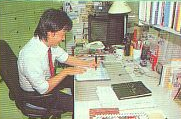
Development for Super Mario Bros. 3 began shortly after Super Mario Bros.: The Lost Levels was finished in the Spring of 1986. Originally, the game was developed with a bird's-eye view in mind, similar to The Legend of Zelda, where the player would be looking down at the characters from above. With jumping as one of Mario's main moves, this overhead view made it difficult to determine whether Mario was touching the ground or not, so the view was switched to the side-view used in earlier titles. However, relics of the overhead view can still be found in the final game, such as the black-and-white checkerboard seen at the title screen.[2]
When Takashi Tezuka was designing concepts for the game, he didn't want it to be like Super Mario Bros.: The Lost Levels where only the levels and difficulty was changed. Instead, he wanted to rework everything, from giving Mario an improved moveset to overhauling the character sprites. Programmers also had what they called a "Map Room", which was a long, narrow meeting room where they looked at sheet papers and programmed map data all day. There were 20 to 30 people working on Super Mario Bros. 3, compared to Super Mario Bros.'s seven or eight. However, Koji Kondo was completely alone on sound design, and he claims it was difficult to come up with music to fit the genre of the game. Additional sounds were possible to use during Super Mario Bros. 3's development which weren't able to be used during Super Mario Bros.'s. The Japanese version of the game was originally planned to release in Spring of 1988, but because of the developers wanting to add so many new features, the game ended up getting pushed back another six months.[2]
The hard part of creating a video game with old characters is making the old characters seem fresh and new.[3][4] In many ways, Super Mario Bros. 3 revived the series and brought many new young and old fans back to the adventures of the Mario Bros. The game was first shown in North America in the 1989 movie The Wizard as a way to advertise it; this also marked the first time that a Mario game was advertised in a movie.
Remakes and ports
Super Mario Bros. 3 was later remade and included in Super Mario All-Stars, with updated graphics and sound for the Super Nintendo Entertainment System, and with further minor upgrades in the re-issue, Super Mario All-Stars + Super Mario World, and the game's eventual port to the Wii as Super Mario All-Stars Limited Edition. A notable addition to the All-Stars version of Super Mario Bros. 3 was a save feature which allow players to save the progress and continue the world where they left off. Additionally, there's a Battle Game feature in the title screen that works differently from the ones featured from the maps in the 2-Player Game Mode. Other than that, retaining some localization changes and certain glitches fixed, gameplay was not altered.
The original game is also one of the 30 titles included in the NES Classic Edition and Nintendo Classic Mini: Family Computer, and was made available as one of the 20 NES titles with added online play at the Nintendo Switch Online subscription service's launch in September 2018.[5]
Super Mario Advance 4: Super Mario Bros. 3
- Main article: Super Mario Advance 4: Super Mario Bros. 3
Super Mario Bros. 3 was ported to the Game Boy Advance handheld system as the fourth and final installation in the Super Mario Advance series, Super Mario Advance 4: Super Mario Bros. 3. It used the same graphics and sounds as the Super Mario All-Stars version, and also incorporated the use of the e-Reader: by scanning in certain cards, players could unlock new items and levels, including content originally from the other classic Mario platformers.
Reception
The game has received critical acclaim and is considered to be one of the greatest games of all time. IGN placed it at the number one spot of their top 100 NES games of all time list[6].
| Reviews | |||
|---|---|---|---|
| Release | Reviewer, Publication | Score | Comment |
| Wii | Lucas M. Thomas, IGN | 9.5/10 | "Super Mario Bros. 3 is still a spectacular adventure today, and the best representation of the Mario universe to come from the NES. Though we would have loved to see a little something extra thrown in for this release, it's difficult to argue against Nintendo's standing policy of just releasing games just as they were when they first arrived. Mario's third adventure still stands well enough on its own to firmly recommend it for download even with its old graphical quirks still in place. The only reasons you shouldn't already be walking to your Wii to launch the Shop and put down your 500 points would be if you're happy with a version of the game you already own, like the 2003 Game Boy Advance re-release, or if you're holding out hope that the visually enhanced Super Mario All-Stars edition will someday arrive as a downloadable option as well. But really, even then, it's five bucks. For one of the greatest video games of all time, and absolutely one of Mario's best ever adventures. So how can you resist adding to that already-enormous lifetime sales total?" |
| Wii | Frank Provo, GameSpot | 9/10 | "Those who already love Super Mario Bros. 3 and have the desire to play the original NES version again will be pleased with this Virtual Console release. It's like reconnecting with a best friend that you haven't seen since you were little. Meanwhile, those who haven't yet immersed themselves in its jump-heavy sweetness have been given a golden opportunity to do so. This is 500 Wii points ($5) well spent." |
| Wii | Nintendo Life Staff, Nintendo Life | 10/10 | "SMB3 cannot come any more highly recommended; it is widely regarded, by many, as the best game on the NES. Some would even say it rivals the magnificent Super Mario World on the SNES, though the jury is out on that one. You owe it to yourself to try both out and decide for yourself. You won’t be sorry!'" |
| Aggregators | |||
| Compiler | Platform / Score | ||
| GameRankings | 97.50% | ||
Release
Merchandise
Among the merchandise based on the game are a Nelsonic Game Watch, and chocolate chip swirl cookies manufactured by Salerno, which features a maze on the box.[7]
id Software's attempted PC port
PC developer id Software sent to Nintendo a demo of a PC port of the game[8], with the intent being to gain authorization to make an official port. The demo reached the Nintendo of Japan management (including Shigeru Miyamoto), who were impressed by the port's quality. However, Nintendo declined to greenlight an official PC version of the game as the company had no plan to release its products outside their own platform[8].
The pitch followed a tech demo named Dangerous Dave in "Copyright Infringement", which was a playable recreation of World 1-1 with Mario's sprite being replaced with that of the titular character. Dangerous Dave was notable for featuring smooth scrolling[9], something unheard for PC games of the time[8][10]. With a distribution deal with Scott Miller of Apogee Software, Ltd., "Copyright Infringement" id developers John Romero and John Carmack along with Tom Hall (who originally had the idea)[citation needed] later used the engine they had developed to create the Commander Keen series, a series of shareware platform games for MS-DOS[11].
On December 14, 2015, John Romero uploaded gameplay footage of the port on the video-sharing website Vimeo[12].
Media
- For a complete list of media for this subject, see List of Super Mario Bros. 3 media.
References to other games
- Mario Bros. - The Battle Mode is very similar to the multiplayer in this game.
- Super Mario Bros. - Buzzy Beetles reuse their sprites from this game but with a few differences. When Princess Toadstool is saved from Bowser (in English versions except Super Mario Advance 4), she says "Thank you. But our princess is in another castle!...Just kidding! Ha ha ha! Bye bye." This is a reference to the mushroom retainers' line "Thank you Mario! But our princess is in another castle!" from this game. Several sound effects from this game are reused. An arrangement of the Underground Theme from this game is used for the underground levels. Also, the Music Box plays an arrangement of the Ground Theme from this game.
- Super Mario Bros.: The Lost Levels - The skidding sound effect returns.
- Super Mario Bros. 2 - Princess Toadstool's appearance is almost identical to how she appeared in this game. Bob-ombs, as well as desert, sky and ice-themed levels/worlds also return.
- The Legend of Zelda series - The "Magic Whistle" item is the Recorder from The Legend of Zelda; it summons a whirlwind to warp the player character to another location and plays the same tune when used, which has become a reoccurring melody in the original series.
- The Mysterious Murasame Castle - The Raccoon Mario transformation sound effect originated from this game.[13]
References in later games
- Super Mario World - The Koopalings return in this game. The Sunken Ghost Ship was once an airship in Super Mario Bros. 3.
- The Legend of Zelda: A Link to the Past - The music for Water Land was remixed as the background music for the Fairy Fountain/Great Fairy Fountains, including the music that plays on the file select screen, which would be used in many Zelda games throughout the subsequent generations of that franchise's history.
- Super Mario Land 2: 6 Golden Coins - Water Land's music can be heard in the background of the music for stage 3 of Tree Zone, as well as in Mario Zone.
- Super Metroid - The sound effect for when Crocomire fully dies is taken from the Dry Bones in Super Mario Bros. 3.[14]
- Super Mario RPG: Legend of the Seven Stars - The music heard in Grate Guy's Casino is a rendition of the music that plays during the minigames of Super Mario Bros. 3, the theme heard during the battle with Bowser is a cover of that from Super Mario Bros. 3, the music for Bowser's Keep also contains part of the same theme, and the music heard from Mario's Pad as well as the Flower Garden cutscene is a cover of Grass Land's theme from Super Mario Bros. 3.
- Super Mario 64 - Many levels in Giant Land resemble Tiny-Huge Island in Super Mario 64 and its DS remake. Changing sizes by using doors also resembles using pipes to go from tiny to huge in Tiny-Huge Island.
- Mario Party - The music heard in Ghost Guess and Pedal Power appears to be a cover of the music for Ice Land. A few other songs from Super Mario Bros. 3, namely the themes for Giant Land and Dark Land, were remixed in this game.
- Mario Party 2 - The jingle that plays when a single player wins in a minigame is a remix of the jingle that plays when the player clears a level.
- Paper Mario - The jingle that plays when Mario rescues a Star Spirit is a cover of the theme that plays when Mario recovers a king's magic wand, which also plays when Mario wins the Star Rod back from Bowser. A remix of the airship theme plays when the Koopa Bros. fire Bullet Bills at Mario and his partners. Their theme is also a remix of the theme for the Hammer Bros. battles. Also, the music that plays when Mario levels up is a remix of Grass Land's music from Super Mario Bros. 3.
- Super Mario Bros. Deluxe - The opening for the game features a letter from Princess Peach in a similar manner to Super Mario Bros. 3.
- Luigi's Mansion - One of the other songs played on Melody's piano is a remix of the Super Mario Bros. 3 athletic theme.
- Super Smash Bros. Melee - The Ground and Grass Land themes are covered in a remix named after Super Mario Bros. 3. Bowser's down special move, Bowser Bomb, is based on the ground pound he uses in Super Mario Bros. 3. Raccoon Mario, Boo and Thwomp also appear as trophies.
- Paper Mario: The Thousand-Year Door - The theme for Ice Land plays when Jolene calls Mario. In addition, Peach also provides vital clues to Mario via (e-)mail, and her last message ends up being intercepted by the main villain (Grodus, in this game's case), similar to in Super Mario Bros. 3.
- The Legend of Zelda: Wind Waker - Like before, the musical themes for the Fairy Fountain/Great Fairy Fountains are derived from Water Land's theme. In addition, another version played with the Fairy Queen, with its melody most closely resembling the original Water Land theme.
- Tetris DS - Levels 4, 5, and 6 in Marathon mode uses Super Mario Bros. 3 gameplay on the top screen, along with the Raccoon, Frog and Tanooki Mario sprites on the touch screen. Also, a cover of the Ground theme plays.
- Dance Dance Revolution: Mario Mix - Music from Super Mario Bros. 3 is remixed in this game.
- WarioWare: Twisted! - The Super Mario Bros. 3 microgame, along with the Super Mario Bros. 3-Lift microgame, are based on Super Mario Bros. 3.
- Super Mario 64 DS - The Rec Room theme is a cover of Grass Land's theme. The Wanted!, Connect the Characters, and Mario's Slides minigames uses the minigame music.
- Mario Party Advance - The music played after Mario beats a Boom Boom/Koopaling is heard after the player completes a quest. Also, in the minigame Drop 'Em, the background has a similar design to the levels from Super Mario Bros. 3.
- Mario Kart DS - The track Airship Fortress is based on the airship levels from Super Mario Bros. 3. Another track, Desert Hills, is based on Desert Land from Super Mario Bros. 3. A few of the Mission Mode arenas are based on the Fortress levels in Super Mario Bros. 3.
- New Super Mario Bros. - Many concepts started in Super Mario Bros. 3 are features in this game, such as Toad Houses. Most of the worlds have similar themes. Plus, the fortress theme is a cover. The fortress boss battle music returns as a cover version. Toad House's music was remixed as the theme for Bob-omb Reverse, a minigame in this game. Bowser's theme from Super Mario Bros. 3 was also remixed in this game.
- Mario & Sonic at the Olympic Games - A remix of the Ground theme from Super Mario Bros. 3 is available as a track that can be heard in the music gallery in the Wii version of the game.
- Super Mario Galaxy - Arrangements of the airship and athletic themes appear in this game.
- Super Paper Mario - The theme that plays when Big Blooper appears is a cover of the underwater theme from Super Mario Bros. 3.
- Super Smash Bros. Brawl - The "Super Mario Bros. 3" theme from Super Smash Bros. Melee is re-used in this game. The music that plays during Peach's Final Smash, Peach Blossom, is a sped up remix of the music that plays in Coin Heavens and the second portion of Sky Land, as well as the Warp Zone. The airship theme is remixed and can be heard on the stage Luigi's Mansion. Also, a medley of the boss theme of Super Mario Bros. 3 (alongside the Super Mario World Castle theme) can be heard on the Luigi's Mansion stage. Raccoon Mario, Boo, Thwomp, and Ludwig von Koopa appear in the form of stickers. Also, Boo, Chain Chomp and Dry Bones appears as trophies and stickers.
- Mario Kart Wii - A license plate which reads "SMB3" can be found on one of the trucks on Moonview Highway.
- Mario & Sonic at the Olympic Winter Games - A remix of the athletic theme is available as a track that can be played during events in the Wii version of this game.
- New Super Mario Bros. Wii - The Penguin Suit is based on the Frog Suit from Super Mario Bros. 3. The Koopalings' battle theme is covered twice and once again played when fighting against them. The airship theme is a cover, and can be heard on airship levels. The map model of the Towers are based on the fortress map sprites of Super Mario Bros. 3. The Enemy Courses are similar to the levels when fighting against a Hammer Bro, Fire Bro, Boomerang Bro, or Sledge Bro, and even use a cover of the song. Also, players can store reserve power-ups like in Super Mario Bros. 3.
- Nintendo 3DS Virtual Console NES games: The sound effect when selecting an NES game is the coin sound effect startup sound for Super Mario Bros. 3.
- Super Mario Galaxy 2 - Supermassive Galaxy is similar to Giant Land.
- Mario Sports Mix - In the underwater theme in Harmony Hustle, a remix of part of the Super Mario Bros. 3 underwater theme can be heard.
- Mario & Sonic at the London 2012 Olympic Games - The athletic theme in Super Mario Bros. 3 is available in the Wii version of this game as one of the optional music tracks that can be heard.
- Super Mario 3D Land - Many Super Mario Bros. 3 elements, like Boom Boom, Tanooki Mario, Note Blocks, and Super Leaves appear in this game. The Airships and Boom Boom battles return, and the arrangements of the Airship and athletic themes from Super Mario Galaxy play in certain stages.
- Mario Kart 7 - The Super Leaf appears as an item.
- Fortune Street - A remix of Pipe Land's theme is used as the stocks menu music. Also, the Toad's House theme is used as the music for auctions. A remix of the "3 Matching Cards" fanfare plays whenever a line is made in Round The Blocks on a Mario board or when the Super Mario tour is completed in Tour mode, as well as a remix of the "World Clear" fanfare playing when a line of lucky 7's is made in Round The Blocks on a Mario board.
- New Super Mario Bros. 2 - Some levels in this game contain the same colorful blocks as Super Mario Bros. 3. Also, Super Leaves, Raccoon Mario, and the Power Meter returns. The loading chime sometimes plays a small part of the Super Mario Bros. 3 Ground theme. The theme for Toad Houses was reused as that of Toad Houses in this game. World 1-1 and 1-5 are remade as part of the Gold Classics Pack.
- New Super Mario Bros. U - The P-Acorn sounds and acts like the P-Wing. Also, the first part of the Soda Jungle is based on Giant Land.
- Mario Tennis Open - A costume and racket of Tanooki Mario can be unlocked in this game.
- Paper Mario: Sticker Star - Goomba's Shoes (known as the Super Boot), a version of Raccoon Mario with only the tail, and Frog Suits return as stickers in this game. The music that plays when riding the ski lift in Whiteout Valley is a remix of the athletic theme from Super Mario Bros. 3. Also, the Kings' theme is remixed for the afterward to a Royal Sticker boss battle in this game. When the host Snifit explains the rules to Snifit or Whiffit, a remix of the Spade Panel music plays.
- Super Mario 3D World - The Super Mario Bros. 3 death jingle is remixed in this game. Spikes and Super Leaves also return.
- NES Remix 2 - Super Mario Bros. 3 is one of the games that appear in this game.
- Mario Golf: World Tour - The music for Sky Island is a cover of the Super Mario Bros. 3 athletic theme. Golf clubs, a golf ball, and a clothing combo appear based on the Super Leaf. There are also golf clubs, a golf ball, and a costume available based on Tanooki Mario.
- Mario Kart 8/Mario Kart 8 Deluxe - Tanooki Mario is a playable character in the downloadable content pack The Legend of Zelda × Mario Kart 8, but is available from the start in Mario Kart 8 Deluxe.
- Super Smash Bros. for Wii U - Music was used in this game as a medley of the athletic, stage clear theme, Giant Land's theme, Hammer Bros. battle theme, and the player miss theme. The Super Leaf is also a usable item, turning fighters into the Raccoon form and allowing them to glide for a while. The Koopalings appear as playable characters as alternate costumes for Bowser Jr.
- Mario Party 10 - Toad's amiibo Party theme is a remix of the theme for Toad Houses from this game. After a Bowser Party is finished, the results music is the lullaby that makes the Hammer, Boomerang, Fire, and Sledge Bros. fall asleep.
- Super Mario Maker/Super Mario Maker for Nintendo 3DS - Super Mario Bros. 3 is one of the game styles for these games. The Course World menu music and 100 Mario Challenge map music are both cover versions of the Grass Land map theme.
- Paper Mario: Color Splash - The 8-bit Recorder and Hammer return in the Super Mario Bros. 3-themed course in Green Energy Plant and can be squeezed into realistic Thing Cards; when the Recorder is used, the original notes are played by the flute itself, and it has the same effect of summoning a whirlwind, while three other flutes play the "Coin Heaven" theme in the background. Additionally, to board an airship carrying a giant bucket of paint, Mario hangs on the Anchor, like he does in Super Mario Bros. 3. Raccoon and Frog Mario also appear as usable card effects. Larry also, like in the Japanese manual for the game, states before fighting Mario, that he is doing his actions specifically to avoid upsetting Bowser. In addition, similar to in Super Mario Bros. 3, after completing a level, Peach will supply Mario with advice via Holo-Peaches, although before the final level, her final message ended up intercepted by the main villain (Black Bowser in this case), although in this case, this resulted in her color being drained rather than being kidnapped.
- Super Mario Run - The background music for Remix 10 features a remix of the Ground theme from Super Mario Bros. 3. One of the minigames available heavily resembles the Battle Mode stage where coins and fireballs spew out of a vertical pipe.
- Super Mario Odyssey - The music that plays in the slots rooms and the picture-matching mini-game areas is a remix of the minigame theme from Super Mario Bros. 3. A remix of the final boss theme from Super Mario Bros. 3 plays when Mario captures Bowser.
- WarioWare Gold - The Super Mario Bros. 3-Lift microgame from WarioWare: Twisted! reappears, referred to as simply "Super Mario Bros. 3".
- Super Smash Bros. Ultimate - New arrangements of the Ground theme (which features the level clear theme and Grass Land's theme), Boss theme (featuring Ice Land and Dark Land's themes), and Final Boss theme (also featuring Dark Land's theme) are available as tracks.
Version differences
- See also: tcrf:Super Mario Bros. 3
There are four known versions of Super Mario Bros. 3 released for Family Computer and Nintendo Entertainment System: the original Japanese version, the North American PRG0 and PRG1 versions (NES cartridges will display NES-UM-USA and NES-UM-USA-1 next to the Nintendo Seal of Quality respectively), and the PAL version. During the two year release gap between the Japanese version and the worldwide release of Super Mario Bros. 3, many changes were made while localizing the game for the international market. Many of the gameplay and level design changes for the international release were kept in the future remakes, while other changes were reverted to make the game closer to the original Japanese version.
Gameplay changes
- In the Japanese version, getting hit while powered-up causes the player to automatically shrink to Small Mario like in Super Mario Bros. In the international versions, powered-up Mario is reverted to Super Mario when hit, then shrinks to Small Mario when hit again. This also applies for the Goomba's Shoe. In the Japanese version, the shoe is red as it flies offscreen, and the player is also reverted to Small Mario; the shoe retains its green color as it is removed for the international versions, and the player keeps any power-ups they had before entering the shoe.
- In Toad Houses, the player can move while Toad is speaking in the Japanese version. In the international versions, the player must wait until the message is completely displayed.
- The timing for the credits sequence was altered for the international versions.
- After the credits end in the international versions, the player can press any button to return to the title screen and start another game in which the inventory is filled with 28 Magic Wings. In the Japanese version, the player cannot do this as the game remains on the ending screen indefinitely and must be restarted. This is one of the few international gameplay changes not retained in the later remakes.
Level design changes
- In the second room of World 1-
 Fortress in the international versions, the door to Boom Boom is at the very end of the room, with the spikes above the door slightly above the rest. Comparatively in the Japanese version, the room is two blocks wider to the right, and the door is one block to the left of the gap in ceiling spikes.
Fortress in the international versions, the door to Boom Boom is at the very end of the room, with the spikes above the door slightly above the rest. Comparatively in the Japanese version, the room is two blocks wider to the right, and the door is one block to the left of the gap in ceiling spikes. - The castle interiors when entering and finishing an airship stage were redesigned for the international versions. Mario is standing in the center of the room rather than on the very left, a third pillar next to the very left one was removed, the column on the right is in front of the stairs rather than behind, the throne and stairs are colored golden rather than being blue like the background wall, the stairs are made slightly longer, and the shadow shading was put on the right of each pillar rather than on the left.
- In World 8-
 , a block was removed off the end of the final ship, allowing players to more easily jump onto the ship should they swim under the fleet.
, a block was removed off the end of the final ship, allowing players to more easily jump onto the ship should they swim under the fleet. - The end of World 5-1 was moved to the end of the main area of the level rather than having a Warp Pipe that takes the player to the end of the stage. A Buster Beetle at that part was also removed for the international versions. This was likely done to remove a glitch allowing the treasure box that appears in the secret area in this level to appear at the end of the level.
Graphical changes
- When the player is hit as Tanooki, Hammer, or Frog Mario, the costume comes off and a sound effect plays in the Japanese version. In the international versions, the costume disappears in a puff of smoke.
- In the Japanese version, when entering a stage, it wipes in to black, then wipes out the stage. In the international versions, it wipes in, then the stage fades in slightly more quickly.
Textual changes
- In the PRG0 version, Castle of Kuppa was changed to Castle of Koopa in the game's ending.
- In the PRG1 version, the names of each world as shown in-game minus Grass Land were further altered; Desert Hill became Desert Land, Ocean Side became Water Land, Big Island became Giant Land, The Sky became Sky Land, Iced Land became simply Ice Land, Pipe Maze became Pipe Land, and Castle of Koopa became Dark Land. This actually makes it closer to how they were originally written in the instruction manuals, including the Japanese one. The Super Nintendo and Game Boy Advance ports, however, reverted back to the original pre-revision names.
- In the PRG0 version, Toad says "Miss twice and your out!" in the N-Mark Spade Panels. The US PRG1 version changes Toad's line to "You can only miss twice!" to get rid of the typo in the PRG0 version.
- Princess Peach mentions in her letter received in World 2 "Kuribo's shoe" in the PRG0 version and "Goomba's shoe" in PRG1 version.
PAL version changes
- The PAL version is based on the US PRG1 version, featuring most of its changes. It was optimized for PAL NES to have its gameplay and music match the Japanese and US versions. Some of the music sounds different as the result, such as the Airship music, where the percussion in the first part isn't cut off.
- Bowser's letter is signed "Koopa Troopa" instead of "King of the Koopa" from the US versions.
Staff
- Main article: List of Super Mario Bros. 3 staff
Directors
Game Designers
- Shigeru Miyamoto
- Takashi Tezuka
Main Programmer
- Toshihiko Nakago
Sound Composer
Producer
- Shigeru Miyamoto
Pre-release and unused content
One of the early ideas was a power-up to turn Mario into a Centaur (half-man, half-horse), although this was rejected before being implemented into the game. (Tilden 1990, 21)
Additionally, Cheep-Cheeps and Para-Beetles respectively have unused tan and green variations, which would have moved faster than their ordinary counterparts.
Glitches
- Main article: List of Super Mario Bros. 3 glitches
Gallery
- For this subject's image gallery, see Gallery:Super Mario Bros. 3.
Princess Toadstool, Toad, and Luigi
Quotes
- "The Tanooki Suit turns into a statue! Even though I knew it wouldn't make sense to some non-Japanese players...I was so excited about it that I left it in." - Shigeru Miyamoto, Super Mario History 1985-2010 booklet
- "We were helped by many people when developing this game. But even with a larger team, I was still the worst gamer of the bunch." - Takashi Tezuka, Super Mario History 1985-2010 booklet
- "This time around, I added a lot of percussion and was able to create tracks that sounded like there were three or more sounds playing at once, resulting in much richer-sounding music." - Koji Kondo, Super Mario History 1985-2010 booklet
Names in other languages
| Language | Name | Meaning |
|---|---|---|
| Japanese | スーパーマリオブラザーズ3 Sūpā Mario Burazāzu Surī |
Super Mario Bros. 3 |
| Chinese (simplified) | 超级马力欧兄弟3[15] Chāojí Mǎlì'ōu Xiōngdì 3 |
Super Mario Brothers 3 |
| Chinese (traditional) | 超級瑪利歐兄弟3[16] [17] Chāojí Mǎlì'ōu Xiōngdì 3 |
Super Mario Brothers 3 |
| Korean | 슈퍼 마리오 브라더스 3 Syupeo Malio Beuladeoseu 3 |
Super Mario Brothers 3 |
Trivia
- According to the Guinness Book of World Records 2008, Super Mario Bros. 3 was the world's best-selling video game, which is false. However, it was the best-selling game not bundled with a console.
- Also, the image used in the book was of Super Mario Advance 4: Super Mario Bros. 3, the remake, which made the same mistake on the back of its box.
- Despite their artwork showing their current color scheme otherwise, NES palette limitations caused Mario's and Luigi's player sprites to have black overalls with no gloves and red/green hat, shirt and shoes (although corrected in the larger Spade sprite), some of the Koopalings' hair and shell colors to be slightly different, and Princess Toadstool to have brown hair, resembling her sprite from Super Mario Bros. 2 and Toad wearing a black vest and red pants. Most of the character's palettes were corrected in later versions.
- Super Mario Bros. 3 is Takashi Tezuka's favorite game in the series[18], as he feels that it is his first masterpiece.
- The events of this game are considered by Shigeru Miyamoto to be a stage play put on by the Mario cast.[19] However, in the remakes, many of the stage play-esque elements, such as shadows being cast onto the backgrounds, are no longer present.
- Some of the game's assets were included in Capcom's Japanese 2003 arcade game Super Mario Fushigi no Janjan Land.
References
- ^ Cite error: Invalid
<ref>tag; no text was provided for refs namedPlayChoice - ^ a b https://www.nintendo.com/nes-classic/super-mario-bros-and-super-mario-bros-3-developer-interview
- ^ http://nintendope.iodized.net/smb3/smb3article2.php
- ^ [1]
- ^ Nintendo Entertainment System – Nintendo Switch Online. Nintendo. Retrieved May 8, 2018.
- ^ [2]
- ^ @VGArtAndTidbits (February 14, 2020). "Super Mario Bros 3 - Chocolate Chip Swirl Cookies box (1990)." Twitter. Retrieved October 5, 2020.
- ^ a b c Dangerous Dave in "Copyright Infringement" (Retrieved July 5, 2013)
- ^ "It looked just like the console version - smooth scrolling and everything." Kushner, David. Masters of Doom: How Two Guys Created an Empire and Transformed Pop Culture, page 52. Retrieved April 16, 2015. Print.
- ^ CuteFloor (January 12, 2008). Dangerous Dave In Copyright Infringement · Unreleased Prototype. YouTube. Retrieved July 5, 2013.
- ^ "Scott was more than ready to make a deal. The gamers said they would use this new technology to create a title specifically for Apogee to release as shareware." Kushner, David. Masters of Doom: How Two Guys Created an Empire and Transformed Pop Culture, page 52. Retrieved April 16, 2015. Print.
- ^ Romero, John. Super Mario Bros. 3 Demo (199). Vimeo. Retrieved December 14, 2015.
- ^ https://www.youtube.com/watch?v=xx0Ij2BTZSY&t=2m2s
- ^ https://youtu.be/ONxKm8uApSc?t=74
- ^ Video from official simplified Chinese website for Super Mario 3D Land. Retrieved April 2, 2020.
- ^ Nintendo Switch Online Hong Kong Official Website. Retrieved May 21, 2020.
- ^ From the official translated name in Super Mario Maker 2
- ^ GameXplain (June 23, 2015). Super Mario Maker Developer Interview - Takashi Tezuka & Yosuke Oshino. YouTube. Retrieved September 16, 2015
- ^ Nintendo UK (September 10, 2015). Mario Myths with Mr Miyamoto. YouTube. Retrieved September 10, 2015.
External links
- Program Details for Super Mario Bros. 3 - Time Attack
- Nintendo Power Special: The making of Super Mario Bros. 3
- Nintendo Power Special: Super Mario Bros. 3 Strategy Guide
- The Mushroom Kingdom - pre-release and unused content from Super Mario Bros. 3
